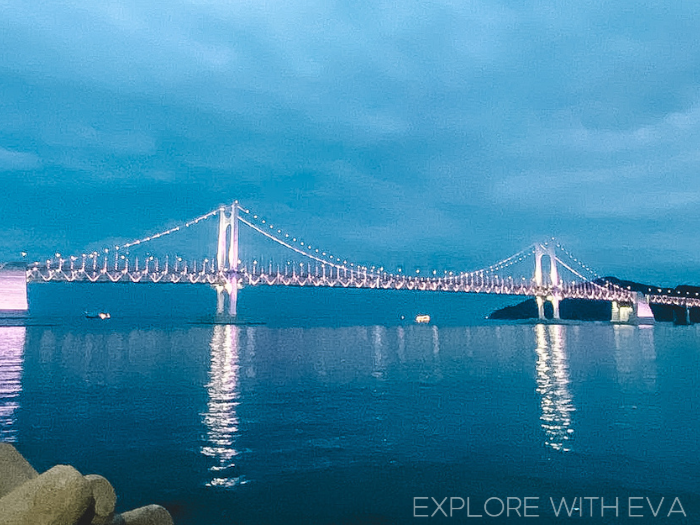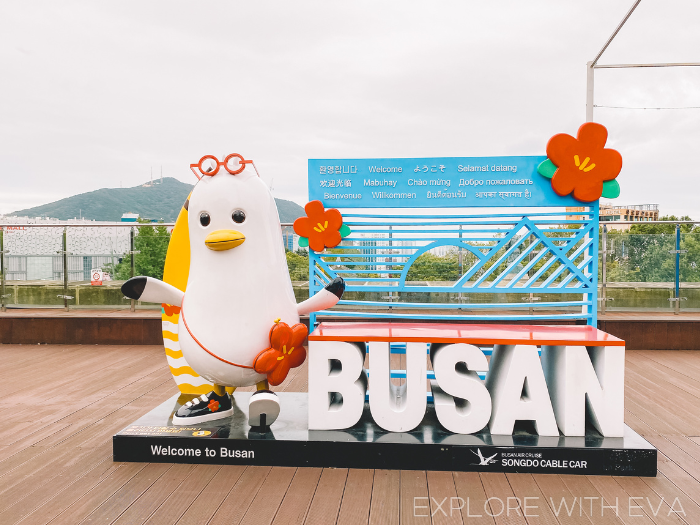Busan, South Korea's vibrant coastal city, beckons with its dazzling beaches, rich culture, and mouthwatering cuisine. It's best explored in three to four days so you can fully experience what it has to offer, but sometimes, we just don't have enough time.
I went to Busan during my first trip to South Korea and stayed for two nights but only had two full days to explore the city. So, I'm sharing my itinerary. Hopefully, you can use this as a guide to a whirlwind adventure that will uncover the best of Busan.
- Day 1: History, Art, and Shopping
- Day 2: Beach Bliss, Breathtaking Views, and Nightlife
- How to Get to Busan From Seoul
- Where to Stay in Busan
- How to Get Around in Busan
Day 1: History, Art, and Shopping
I started my Busan adventure by catching the earliest train from Seoul via KTX. I booked my tickets and reserved my seats in advance using the Korail Pass. Before leaving Seoul, I got some food at a convenience store to have something to eat during the train 2-hour-ish train ride.
Magnate Cafe
From Busan station, get on a bus that'll take you to Magnate Cafe - the coffee shop owned by BTS Jimin's dad. This is a must-visit if you're a fan of BTS. Otherwise, you can skip this and get on with the rest of this itinerary.
After having coffee and snacks at Magnate Cafe, I took the bus to my hotel to drop off my backpack.
Gamcheon Culture Village
From my hotel, I took the subway and bus to Gamcheon Culture Village, where you can unleash your inner art enthusiast. This whimsical neighborhood features colorful houses adorned with street art. Get lost in the maze-like alleys, discover hidden artistic gems, and capture some Instagram-worthy photos!
 |
| Gamcheon Culture Village |
BIFF Square
Then take the bus going to BIFF Square. Here, you can find handprints of renowned actors and actresses immortalized in the heart of the city.
Yongdusan Park
Just a short walk from BIFF Square is Yongdusan Park, where you can find peaceful gardens and stunning panoramic views of the city skyline.
Don't forget to snap a picture with the iconic Busan Diamond Tower, a landmark that glitters against the backdrop of the ocean. If you are okay with spending extra, I'd highly recommend going up the tower for panoramic views of Busan.
 |
| Busan Diamond Tower |
Nampo Market
I ended the day in the bustling Nampo Market, which is a haven for shoppers and foodies alike. From fresh seafood to local crafts and souvenirs, this traditional market offers a sensory overload in the best way possible. Don't forget to try some local street food!
Day 2: Beach Bliss, Breathtaking Views, and Nightlife
My second day in Busan was also my last full day, as I had planned to leave the city early the next day for a quick stop at Daegu before returning to Seoul.
If you must return to Seoul on the second day, it's worth noting that the last train departs around 10pm from Busan Station, giving you plenty of time to explore the city before departure. So if you plan to do this, I'd recommend going to the station first to leave your bag in a locker. Rates start from KRW2,000 for 4 hours, then you pay extra for additional hours. Alternatively, you can ask your hotel if you can leave your bag, but this might be a hassle if your hotel is far from the train station.
Haeundae Beach
I started the day at Haeundae Beach, which is Busan's most famous stretch of golden sand. Here, you can relax on the beach or take a dip in the refreshing waters - which I skipped because I had limited time. I just went here to admire the views and snap some photos.
 |
| Haeundae Beach |
Blueline Park Sky Capsule
I then walked to Mipo Station at Blueline Park. Here, you can take the Sky Capsule or Beach Train from Mipo Station to Cheongsapo Station or vice versa for breathtaking views of the coastline. For this itinerary, I did the Mipo-to-Cheongsapo route.
Cheongsapo Daritdol Observatory
Upon arriving at Cheongsapo Station, I made a quick stop at the souvenir shop to buy some trinkets. Then, I headed to the Cheongsapo Daritdol Observatory for even more panoramic views. This observatory is over 70m long and 20m high, and it stretches out impressively over the ocean. Some parts of the deck floors are even made of glass so you can see the ocean under your feet.
 |
| Cheongsapo Daritdol Observatory |
Haedong Yonggungsa Temple
From the observatory, I took the bus to the Haedong Yonggungsa Temple, which is a picturesque seaside temple located on the northeastern coast of Busan. Known for its stunning ocean views and unique blend of Buddhist architecture, it attracts visitors seeking tranquility.
On the way to the temple, you'll walk on a narrow street with lots of souvenir stores and food stalls, where you can also try some local street food. I tried the fish cakes, which were some of the best fish cakes I've tried in South Korea.
 |
| Haedong Yonggungsa Temple |
Gwangalli Beach
As the sun was setting, I headed to Gwangalli Beach to experience the dazzling spectacle of the Diamond Bridge illuminated against the twilight sky. Immerse yourself in the vibrant nightlife here and grab a drink while soaking in the views.
Gukje Market
I ended my Busan adventure on a delicious note at the Gukje Market - I just love these food markets. This place offers a vast array of cuisines from around the world. From Gukje Market, you can then take the subway to Busan Station and catch the KTX to Seoul.
How to Get to Busan From Seoul
Getting to Busan from Seoul is convenient and easy. One of the most popular options is taking the high-speed KTX train, which offers frequent departures from Seoul Station to Busan Station. The journey takes approximately 2 hours and 30 minutes, providing passengers with a comfortable and scenic ride through the countryside. If you're taking the KTX, I highly recommend getting the Korail Pass to spend less on your train tickets.
 |
| views from Cheongsapo Daritdol Observatory |
Alternatively, travelers can opt for a bus ride from Seoul Express Bus Terminal to Busan Central Bus Terminal, with multiple departures throughout the day. The bus journey typically takes 4 to 5 hours, depending on traffic conditions.
For those preferring air travel, flights from Gimpo International Airport to Gimhae International Airport in Busan are available, with flights averaging around 1 hour and 20 minutes.
Where to Stay in Busan
Choosing the best area to stay in Busan largely depends on your preferences, interests, and travel plans. However, several neighborhoods stand out for their unique attractions, accessibility, and amenities.
 |
| view of Gwangan Bridge from Gwangalli Beach |
Here are some of the top areas to consider for accommodation in Busan.
- Haeundae Beach: This area offers a vibrant atmosphere with many hotels, guesthouses, and resorts catering to all budgets. Staying in Haeundae provides easy access to the beach and nearby attractions like Dongbaek Island, Nurimaru APEC House, and the SEA LIFE Busan Aquarium. The area is also known for its lively nightlife.
- Nampo-dong: Located in the heart of Busan, Nampo-dong is a bustling district known for its shopping streets, cultural attractions, and culinary delights. Stay in Nampo-dong within walking distance of landmarks such as Jagalchi Fish Market, BIFF Square, and Gamcheon Culture Village. The area is also well-connected to public transportation.
- Seomyeon: As Busan's commercial and entertainment hub, Seomyeon offers a lively atmosphere with an abundance of shopping malls, restaurants, and entertainment venues. Staying in Seomyeon provides convenient access to underground shopping centers. The area is also a transportation hub, with bus and subway connections to various parts of the city.
- Gwangalli Beach: For a more relaxed and scenic experience, consider staying near Gwangalli Beach. While not as crowded as Haeundae, Gwangalli offers stunning views of Gwangan Bridge and a wide range of dining options along the waterfront promenade.
During the Busan leg of my trip, I stayed in the Seomyeon area because of its accessibility. Upon checking the maps, I noticed that it appears to be in the middle of the other neighborhoods, which makes it a great area to stay in if you want to visit many places in the city. You can book your accommodations through Agoda and just filter out the search results by neighborhood.
How to Get Around Busan
Since Busan is also a metropolitan city, much like Seoul, getting around is convenient. The Busan Metro, consisting of four lines, covers most of the city's major attractions and neighborhoods. Additionally, buses provide coverage of areas inaccessible by the metro. Don't forget to purchase a T-money or Cashbee card to conveniently pay for trains and buses. If you want an even more convenient way to get around, you can always get a taxi.
My trip to Busan was short and sweet, and I wish I had more days. I will definitely come back and stay longer to experience more of the city and everything else it offers.
I hope you find this helpful. With this itinerary, you'll be well on your way to exploring Busan in just two full days. If you have any questions, leave a comment below, and I'll be happy to answer them!





0 Comments